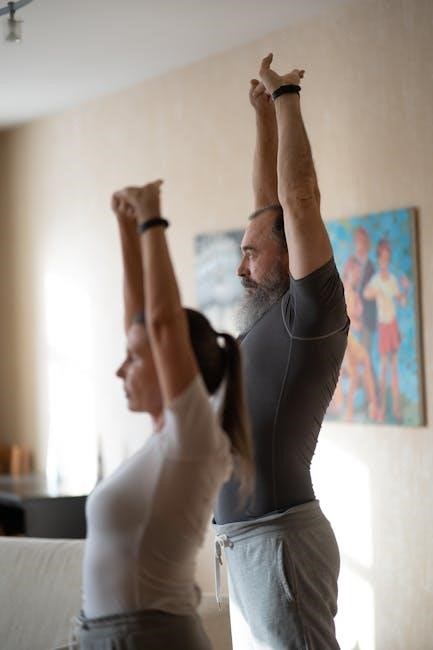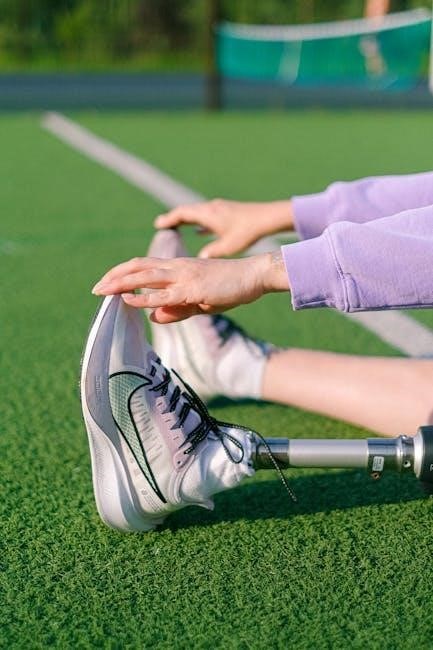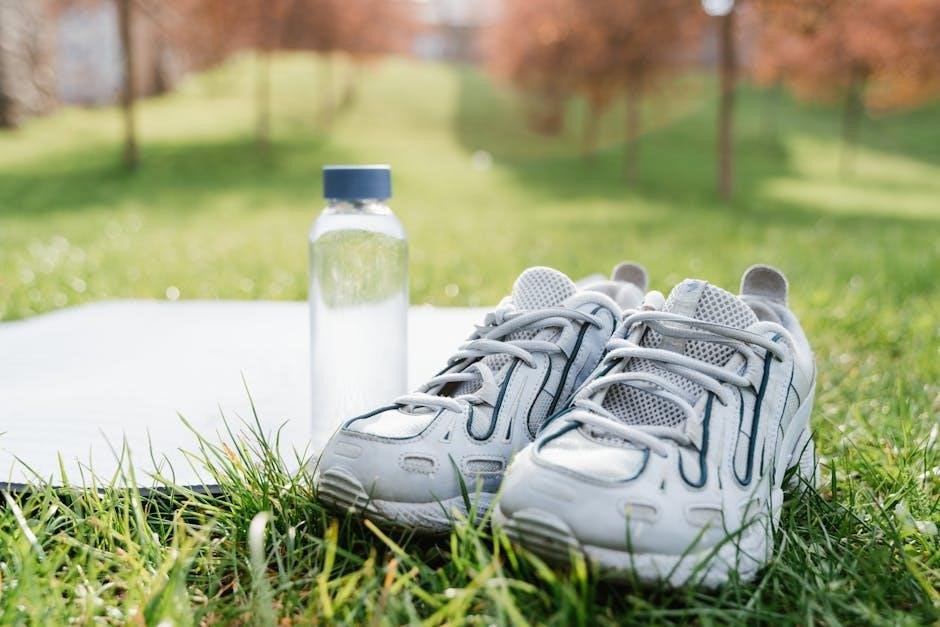Mobility exercises are essential for enhancing movement and joint health, offering a comprehensive guide to improving flexibility and range of motion through targeted routines․
What Are Mobility Exercises?
Mobility exercises are movements designed to improve joint function, dynamic flexibility, and overall movement quality․ They focus on enhancing the range of motion, reducing stiffness, and strengthening muscles around joints․ These exercises are dynamic, unlike static stretches, and are often used in fitness, rehabilitation, and sports performance․ They target specific areas like the neck, shoulders, hips, and ankles to promote fluid movement․ Regular practice helps maintain joint health and prevents injuries, making them a cornerstone of any wellness or training program․ Mobility exercises are versatile and can be adapted to suit different fitness levels and goals․
Why Mobility Exercises Are Essential
Mobility exercises are vital for maintaining optimal physical function and overall well-being․ They improve joint health, enhance flexibility, and reduce the risk of injury․ By incorporating these exercises into a daily routine, individuals can experience better movement quality, which is crucial for both athletic performance and everyday activities․ Mobility exercises also play a key role in rehabilitation, helping to restore function after injuries․ Consistent practice promotes dynamic movement, ensuring joints operate efficiently and effectively․ This makes mobility exercises an indispensable part of any fitness or wellness program, supporting long-term physical health and active lifestyles․

Benefits of Incorporating Mobility Exercises
Mobility exercises enhance joint health, boost flexibility, and prevent injuries, offering a comprehensive approach to improving physical function and overall well-being through targeted movements and routines․
Improved Joint Health
Mobility exercises significantly enhance joint health by reducing stiffness and inflammation, promoting lubrication, and strengthening surrounding tissues․ They improve the range of motion, preventing degenerative conditions like arthritis․ Regular practice reduces joint wear and tear, fostering fluid movement and stability․ Incorporating exercises like hip circles, leg swings, and cat-cow stretches can alleviate existing joint discomfort․ Consistency in mobility routines ensures long-term joint vitality, enabling better overall physical function and reducing the risk of injuries․ Guidance from professionals further optimizes these exercises for targeted joint care, making them essential for maintaining healthy, resilient joints throughout life․
Enhanced Flexibility and Range of Motion
Mobility exercises play a crucial role in enhancing flexibility and range of motion by targeting specific joints and muscles․ Regular practice reduces muscle tension, allowing for smoother, more fluid movements․ Exercises like leg swings, arm circles, and hip opens help improve flexibility while increasing joint mobility․ These routines also promote better posture and reduce the risk of muscle imbalances․ By incorporating dynamic stretches and movements, mobility exercises ensure that flexibility is functional, translating into real-world activities․ Consistent practice enhances overall movement efficiency, making daily tasks and physical activities easier and less strain-inducing, while also supporting long-term musculoskeletal health․
Injury Prevention and Rehabilitation
Mobility exercises are vital for injury prevention by improving joint stability and reducing muscle stiffness․ They strengthen connective tissues, lowering the risk of strains and sprains․ In rehabilitation, these exercises help restore movement after injuries, reducing inflammation and promoting recovery․ Targeted routines, like ankle or knee mobility drills, guide the body back to optimal function․ Experts often design programs to address specific injuries, ensuring safe and effective progress․ Consistent practice not only prevents future issues but also enhances overall resilience, making mobility exercises a cornerstone of both injury prevention and rehabilitation strategies․

Understanding Flexibility vs․ Mobility
Mobility involves dynamic joint movement, while flexibility refers to the range of motion in a specific joint․ Both are enhanced through targeted exercises, improving function and reducing stiffness․
Key Differences Between Flexibility and Mobility
Flexibility refers to the range of motion in a stationary joint, while mobility involves dynamic movement, incorporating strength and coordination․ Mobility exercises enhance joint function by combining movement with muscle activation, unlike static stretching, which focuses solely on flexibility․ Mobility also addresses joint stability and control, allowing for more efficient movement patterns․ It involves multiple joints and muscle groups, making it a holistic approach to improving physical function․ This distinction highlights that mobility is not just about stretching but also about how well joints and muscles work together during active movements․
How Mobility Exercises Promote Dynamic Movement
Mobility exercises enhance dynamic movement by improving joint range, muscle coordination, and functional strength․ They involve active movements that mimic real-life actions, such as squatting or lunging, which prepare the body for everyday tasks and sports․ Unlike static stretches, mobility exercises engage multiple joints and muscle groups simultaneously, fostering fluid transitions between movements․ This approach reduces stiffness, improves posture, and enhances overall athleticism․ Regular practice ensures joints can move efficiently through their full range, promoting smooth, unrestricted motion․ This makes mobility exercises essential for maintaining physical fitness and preventing injuries․

Popular Mobility Exercises for Full-Body Movement
Popular mobility exercises include neck, shoulder, hip, lower back, knee, and ankle movements, targeting joint flexibility and improving overall physical functionality for daily activities and sports․
Neck Mobility Exercises
Neck mobility exercises focus on improving flexibility and range of motion in the cervical spine․ A key exercise involves sitting straight with relaxed shoulders, gently bringing the ear toward the collarbone․ This stretch targets the upper trapezius and supraspinatus muscles, enhancing neck movement․ Regular practice reduces stiffness and improves posture․ Other exercises include slow, controlled rotations and tilts, ensuring dynamic movement and joint health․ These routines are especially beneficial for individuals with desk jobs or those recovering from injuries, promoting overall neck flexibility and comfort in daily activities․ Consistency is crucial for long-term benefits․
Shoulder Mobility Exercises

Shoulder mobility exercises target the deltoids, rotator cuffs, and surrounding muscles to enhance flexibility and joint function․ Key exercises include arm circles, cross-body stretches, and shoulder blade squeezes․ These movements improve range of motion, reduce stiffness, and prevent injuries․ Regular practice promotes better posture and reduces shoulder tension, especially for those with sedentary lifestyles․ Dynamic stretches like overhead reaches and side-to-side rotations further enhance mobility․ Consistency in these exercises supports long-term shoulder health and overall upper body movement, making them essential for both fitness enthusiasts and individuals recovering from shoulder-related injuries․

Hip Mobility Exercises
Hip mobility exercises are crucial for improving lower body movement and joint health․ Key exercises include the Cossack Squat, 90/90 Stretch, Frog Stretch, and Clamshell․ These movements target the hip flexors, glutes, and piriformis, enhancing flexibility and range of motion․ Regular practice reduces stiffness, improves posture, and prevents injuries․ Dynamic stretches like lunges and leg swings further promote fluid movement․ Consistency in these exercises supports better athletic performance and everyday activities, making them essential for maintaining healthy, mobile hips․ Incorporating these routines into your practice ensures long-term benefits for joint function and overall lower body mobility․
Lower Back Mobility Exercises
Lower back mobility exercises are vital for maintaining a healthy spine and preventing stiffness․ Key exercises include the Knee to Chest stretch, Cat-Cow movements, and gentle twists․ These exercises target the lumbar region, enhancing flexibility and reducing tension․ Regular practice improves posture, alleviates back pain, and promotes better movement patterns․ Incorporating these exercises into your daily routine supports long-term spinal health and overall mobility․ Consistency is key to achieving optimal benefits and preventing injuries related to limited lower back movement․
Knee Mobility Exercises
Knee mobility exercises are designed to improve flexibility and reduce stiffness in the knee joint․ Essential exercises include the Knee to Chest stretch, Heel Slides, and Straight Leg Raises․ These movements target the surrounding muscles and ligaments, enhancing joint health and range of motion․ Regular practice helps prevent injuries, alleviates pain, and supports overall lower body mobility․ Incorporating these exercises into your routine promotes better movement patterns and long-term joint stability․ Consistency is crucial for maximizing benefits and maintaining healthy knee function in daily activities and sports performance․

Ankle Mobility Exercises
Ankle mobility exercises are crucial for improving flexibility and reducing stiffness in the ankle joint․ Essential exercises include Ankle Circles, Calf Stretch, and Heel Raises․ These movements enhance joint health and range of motion, reducing the risk of injuries․ Regular practice supports rehabilitation, alleviates pain, and boosts overall lower body mobility․ Incorporating these exercises into your routine promotes better movement patterns and long-term joint stability․ Consistency is key for maximizing benefits and maintaining healthy ankle function in daily activities and sports performance․

Creating a Daily Mobility Routine
A daily mobility routine should include dynamic stretches, joint exercises, and muscle activations․ Start with major joints, progress to full-body movements, and finish with static stretches for optimal flexibility and joint health․ Consistency is key to improving mobility and preventing stiffness․ Aim to practice at least once daily, adjusting exercises based on individual needs and goals․ Regular practice enhances movement efficiency and overall physical wellbeing․
How to Structure Your Daily Mobility Practice

Begin with dynamic stretches to warm up muscles and joints․ Focus on major areas like hips, shoulders, and knees․ Incorporate joint-specific exercises to enhance range of motion․ Include muscle activation techniques to improve stability․ Finish with static stretches to promote flexibility․ Aim for a 4-6 minute total body routine, ensuring consistency․ Adjust exercises based on individual needs and goals․ Regular practice improves movement efficiency and joint health․ Refer to a mobility exercises PDF for detailed guidance and visual demonstrations to ensure proper form and technique․ Consistency is key to achieving long-term benefits in mobility and overall physical wellbeing․
Importance of Consistency in Mobility Training
Consistency is crucial for maximizing the benefits of mobility training․ Regular practice enhances joint health, improves flexibility, and prevents stiffness․ Over time, consistent routines strengthen connective tissues, reducing injury risk․ Even short daily sessions can lead to significant improvements in range of motion and overall movement efficiency․ A well-structured mobility exercises PDF provides guidance, ensuring routines are performed correctly and progressively․ Without consistency, progress may stagnate, and the body may revert to limited mobility․ Making mobility training a daily habit fosters long-term physical resilience and supports an active, healthy lifestyle․

Role of Experts in Designing Mobility Programs
Experts with degrees in Athletic Therapy and Exercise Science develop structured mobility programs, often collaborating on resources like FAME, which include guides and manuals for effective training․
How Professionals Develop Effective Mobility Exercises
Professionals create mobility exercises by assessing joint limitations and designing routines to enhance flexibility and movement․ They often collaborate on programs like FAME, incorporating evidence-based techniques to improve range of motion and reduce inflammation․ Experts use their knowledge in Athletic Therapy and Exercise Science to tailor exercises, ensuring they are safe and effective for various needs․ These routines are documented in PDF guides, providing clear instructions for daily practice, such as neck stretches and hip mobility exercises․ Their structured approach ensures comprehensive improvement in physical wellbeing․
The Importance of Guidance in Mobility Training
Expert guidance in mobility training ensures exercises are performed safely and effectively, maximizing results while minimizing injury risks․ Professionals with expertise in Athletic Therapy and Exercise Science design structured routines, such as the FAME program, to address specific needs․ Their knowledge helps tailor exercises for joint health and flexibility․ Guidance also provides clarity, as seen in PDF guides offering step-by-step instructions for daily practices․ Proper supervision and personalized advice enhance the effectiveness of mobility routines, making them accessible and beneficial for all individuals seeking to improve their physical wellbeing through targeted exercises․
Mobility exercises are crucial for enhancing joint health and overall wellbeing․ Utilize expert-designed PDF guides to incorporate effective routines into your daily life, ensuring optimal physical function and flexibility․
Final Thoughts on the Importance of Mobility Exercises
Mobility exercises are a cornerstone of maintaining joint health and overall physical function․ They enhance flexibility, prevent injuries, and promote dynamic movement, essential for everyday activities and long-term wellbeing․ Incorporating these exercises into your routine, guided by expert-designed PDF resources, ensures a comprehensive approach to improving mobility․ Consistency and proper form are key to maximizing benefits․ Prioritize mobility training to maintain optimal joint health and enjoy a more active, pain-free lifestyle․ Regular practice, supported by professional guidance, will help you achieve lasting improvements in flexibility and movement efficiency․